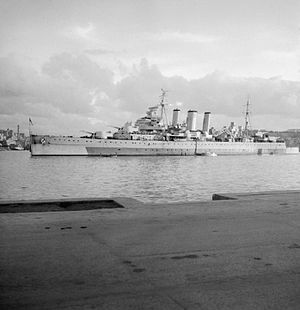HMS Cumberland (57)
 |
|
| History | |
|---|---|
|
|
|
| Name: | HMS Cumberland |
| Builder: | Vickers-Armstrong, Barrow in Furness |
| Laid down: | 18 October 1924 |
| Launched: | 16 March 1926 |
| Commissioned: | 23 February 1928 |
| Recommissioned: | 1951 |
| Decommissioned: | 1946 |
| Fate: | Sold for scrap 1959 |
| General characteristics | |
| Class and type: | County-class heavy cruiser |
| Displacement: |
|
| Length: | 630 ft (190 m) |
| Beam: | 68 ft 3 in (20.80 m) |
| Draught: | 16 ft 3 in (4.95 m) |
| Propulsion: |
|
| Speed: | 31.5 knots (58.3 km/h) |
| Range: | 3,100 nautical miles at 31.5 knots (5,740 km at 58 km/h), 13,300 nautical miles at 12 knots (24,600 km at 22 km/h); 3,400 tons (3,450 t) fuel oil |
| Complement: | 679 (710 as flagship) |
| Armament: |
|
| Armour: |
|
| Aircraft carried: | Three aircraft with one catapult, removed in 1942 |
| Notes: | Pennant number 57 |
HMS Cumberland was a County-class heavy cruiser of the Royal Navy that saw action during the Second World War.
Cumberland served on the China Station with the 5th Cruiser Squadron from 1928 until 1938, returning to the UK in March 1935 for a refit. In 1938, she joined the 2nd cruiser squadron on the South American station.
At the start of the Second World War in 1939, Cumberland was assigned to 2nd Cruiser Squadron Force G, the South American Division. At the start of December she was forced to self-refit in the Falkland Islands, thus depriving the force of their strongest unit. Without her, HMS Exeter, Ajax and Achilles engaged the German raider Admiral Graf Spee in the Battle of the River Plate on 13 December. Cumberland received a garbled indication that a contact was being made and moved north to reinforce, arriving at the River Plate at 22:00 14 December, after steaming for 34 hours. Admiral Graf Spee had put into neutral Montevideo and was trapped there, as Cumberland along with Ajax and Achilles (Exeter having been heavily damaged) patrolled the estuary, resulting in Admiral Graf Spee being scuttled by her crew on 17 December.
After this she sailed to Simonstown, South Africa, spending between January and February undergoing a refit. She then escorted convoys along the African coast, bound for the Middle East. In July she was tasked, along with her sister, HMS Cornwall, with hunting down the German commerce raider Thor (known as Raider E to the Royal Navy). Whilst on patrol, she intercepted and sank the Vichy French merchant Poitiers, which had been carrying ammunition to the Ivory Coast. Later that month she attacked Dakar, suffering damage from a French coastal battery. In December, Cumberland was again hunting for the merchant raider Thor, but the search proved unsuccessful.
...
Wikipedia
